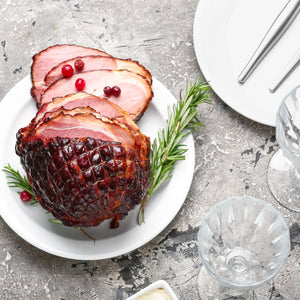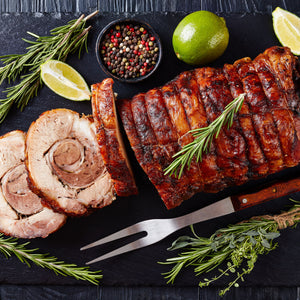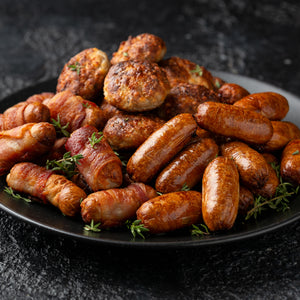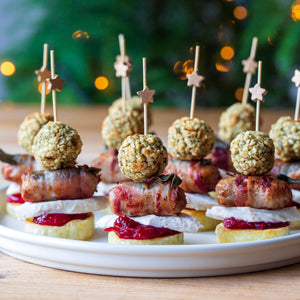How to cook a Christmas dry cured ham
Ingredients
For the ham
1 x 3.2 kg free-range, dry-cured ham
2 carrots
2 celery sticks
1 onion/ green part of a leek or both
2 bay leaves
6-9 whole peppercorns
For the glaze
1.5 tbsp honey
1.5 tbsp brown sugar (I use dark brown sugar)
2 tbsp of mustard (I use Dijon, but you can use English or wholegrain)
To cook your dry-cured ham perfectly, you will need the equipment below
Equipment
- A pot with a lid large enough to fit the ham comfortably.
- A large roasting dish lined with aluminium foil.
- A meat thermometer (not essential but incredibly helpful).
Follow this method for a simple step-by-step guide to cook your glazed Christmas Ham
Method
1. Pop the ham in the pot and cover with cold water until it is completely submerged. Bring the water to the boil and simmer for 5 minutes. There will be a white foam on the water which is simply the excess cure from the ham. We don’t want this in the stock so make sure to drain the ham, throwing away this water. Fill the pot up again with fresh cold water and return to the stove.
2. Add all the chopped vegetables, bay leaves and peppercorns to the water and slowly bring the ham to the boil.
3. As soon as the water is boiling, turn the heat down low. The water should barely be moving, only with small bubbles and a slight tremble. The temperature of the water should be 85 degrees Celsius (this is where a temperature probe comes in very handy).
4. Poach the ham for 25 minutes per 500g, plus 25 minutes at the end. You are looking for a temperature of 75 degrees Celsius in the centre of the ham (meat thermometer coming in handy again). A 3.2kg ham takes 3.5 hours to reach 75 degrees Celsius.
5. Heat your oven to 210 degrees Celsius, and line a baking tray with two layers of foil.
6. Remove the ham from the pot and let it cool slightly (cool enough that you can handle it). The pot is now full of delicious ham stock - strain this to keep for soups and stews. While the ham is cooling, make the glaze by mixing the mustard, sugar and honey in a bowl and set aside.
7. When the ham is mostly cooled, snip off the string and remove. Take a knife and carefully remove the skin and discard, leaving the fat on the ham. Score the ham fat in a crisscross pattern, and place the ham onto a foil lined baking tray.
8. Brush the ham with ½ of the glaze. Pay most attention to the fat, putting most of the glaze on here, with some on the meat too. Place into your preheated oven and check every 2 minutes. It can colour and burn very quickly so keep an eye on it, regularly basting with more glaze.
9. After a couple of bastings, brush the remainder of the glaze over and return to the oven for another 2 minutes. The ham is done when you like the way it looks. Remove from the oven and leave in the tray for 30 minutes.
10. Once the ham is cooled, baste one last time, and put on your favourite platter to serve.
11. It is always easier to carve cold so if you aren’t eating straight away, leave it to cool completely (refrigerated overnight is best) and carve with a very sharp carving knife (not serrated).






